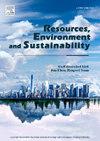Widening inequality: Diverging trends in CO2 and air pollutant emissions across Chinese cities
IF 12.4
Q1 ENVIRONMENTAL SCIENCES
引用次数: 0
Abstract
Chinese cities face escalating tensions between pollution mitigation and economic equity. Using an environmentally extended multi-regional input–output (EE-MRIO) model, we quantified the carbon and air pollutant footprints of 309 cities from 2012 to 2017 and applied structural decomposition analysis (SDA) to identify key emission drivers. The results indicate that inequality in air pollutant emissions, with a Gini coefficient of 0.31–0.53, is significantly higher than that of CO2 (0.33–0.41). Developed cities generate 3.1 times more economic output per unit of CO2 emissions than less developed cities, with the disparity widening over time. While intermediate input optimization contributed to a 1.94 Gt reduction in CO2 emissions, its benefits were largely concentrated in developed regions and were accompanied by increased emissions of PM, BC, OC, and CO. Although reductions in emission intensity played a crucial role in mitigating pollutants, they paradoxically contributed to CO2 growth in energy-intensive cities. Additionally, population growth and per capita final demand were the primary drivers of emission increases, and population growth had a greater impact on developed regions. These findings underscore the need for regionally differentiated policies, including carbon quota reallocation, industrial transformation in energy-dependent cities, and the promotion of green industries in less developed areas, to achieve a balance between environmental sustainability and economic development.

日益扩大的不平等:中国城市二氧化碳和空气污染物排放的不同趋势
中国城市面临着污染缓解与经济公平之间日益紧张的局面。采用环境扩展的多区域投入产出(EE-MRIO)模型,对2012 - 2017年309个城市的碳足迹和空气污染物足迹进行量化,并应用结构分解分析(SDA)识别关键排放驱动因素。结果表明,大气污染物排放不平等的基尼系数为0.31 ~ 0.53,显著高于二氧化碳排放不平等的基尼系数(0.33 ~ 0.41)。发达城市每单位二氧化碳排放产生的经济产出是欠发达城市的3.1倍,而且差距随着时间的推移而扩大。虽然中间投入优化减少了1.94 Gt的二氧化碳排放量,但其效益主要集中在发达地区,并伴随着PM2.5、BC、OC和CO排放量的增加。尽管排放强度的降低在缓解污染物排放方面发挥了关键作用,但它们却矛盾地促进了能源密集型城市的二氧化碳排放量增长。此外,人口增长和人均最终需求是排放增加的主要驱动因素,人口增长对发达地区的影响更大。这些研究结果强调需要采取区域差别化政策,包括碳配额再分配、能源依赖型城市的产业转型和促进欠发达地区的绿色产业,以实现环境可持续性和经济发展之间的平衡。
本文章由计算机程序翻译,如有差异,请以英文原文为准。
求助全文
约1分钟内获得全文
求助全文
来源期刊

Resources Environment and Sustainability
Environmental Science-Environmental Science (miscellaneous)
CiteScore
15.10
自引率
0.00%
发文量
41
审稿时长
33 days
 求助内容:
求助内容: 应助结果提醒方式:
应助结果提醒方式:


